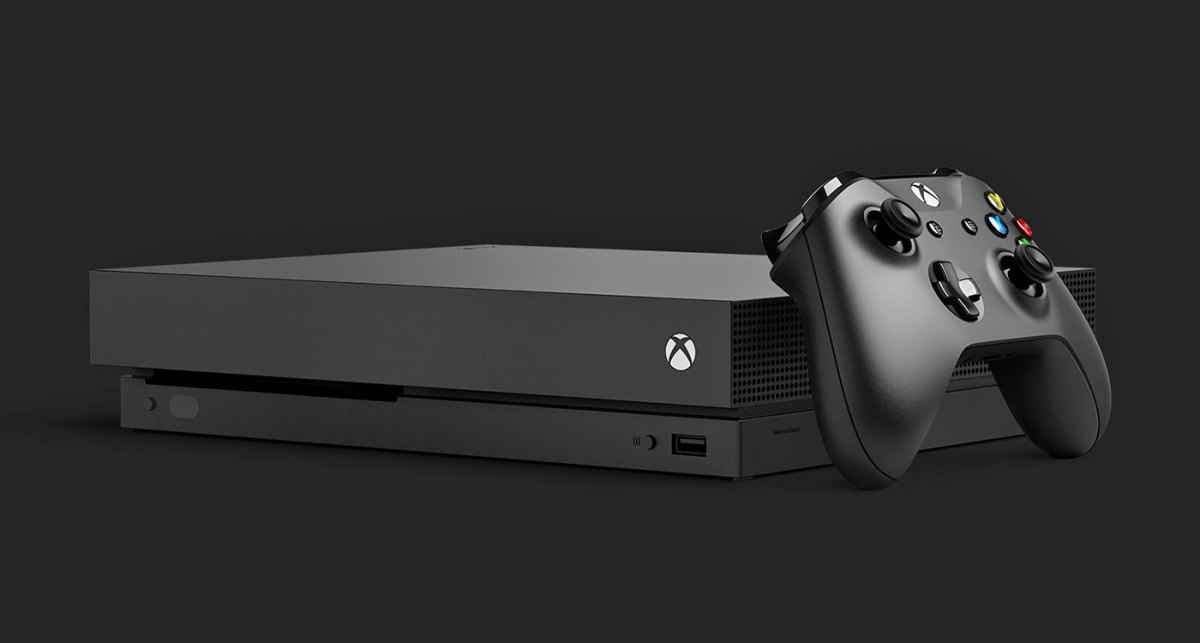Double the bawks
I have the good fortune of being able to cover console launches before, during, and after their release, which gives me plenty of time to study trends. Seeing Microsoft riding high off of the Xbox 360, clawing at Sony after their big Xbox versus PS2 battle, was something else — as was the blowback from the Xbox One’s draconian DRM stance.
They’re still licking their wounds over that, but they’ve bounced back when it comes to console features. As a result of being in second (and possibly third if the Switch keeps it up), they’ve given us backward compatibility for both Xbox and Xbox 360 titles and PC/Xbox One cross-buy, among a number of other small adjustments that beat Sony to the punch (like external hard-drive support, which Sony eventually acquiesced).
It’s been a rough generation for Microsoft, but the Xbox One X delivers. As long as you have a 4K TV.

Design:
Amazingly, Microsoft has been shrinking the size of each Xbox, although I think they’ve hit their limit with the X. As you can see it’s roughly the same size as the S (the X is little smaller in reality at 11.8 x 9.4 x 2.4 inches, though it weighs roughly two more pounds), which is impressive. It’s not the sexiest-looking box but it gets the job done and doesn’t take up a whole lot of space doing it.
As far as the upgrade process goes, Microsoft has bent over backwards to make it as painless as possible. I opted for the external HDD option, and literally just transferred everything to it, from the actual games to my system settings. When I plugged in my Xbox One X I just attached the HDD, signed in, and everything, including my save files by way of the cloud, were there. That’s around 15 seconds of setup time for a new console — not bad! If you want you can also go for a network transfer that will take a little more time and doesn’t require the use of an external device. Or, you could manually re-download your stuff, set the X as your new home console, and re-configure your settings.
After I booted everything up, I quickly found my favorite new “X-centric” UI option — the “enhanced” tab. When looking at both currently installed software and currently owned products, I could easily see which games had Xbox One X updates with a quick filter. It makes everything so much more painless than say the PS4 Pro, where you aren’t quite sure if there’s a point in owning a shinier piece of hardware unless you look up a developer blog for more information.
There are a few things I think could be tweaked in future packages though. For one, the controller is just a run-of-the-mill remote, which doesn’t feel nearly as special as the white, slightly enhanced one you get with the S. My other annoyance is the included HDD — it’s 1TB on the X, and I miss the 2TB on the S already. As I stated plugging in a 2TB HDD is simple enough and I’m not exactly hurting for space, but with tons of 50GB+ downloads to my name it does get a little dicey if I have a lot of shooters installed. It’s going going to get dicier as more size-intensive Xbox One X updates arrive.

Is it worth the 4K push?
Let’s take a look at the specs before we get to the hands-on part. Microsoft is boasting that the X has “40% more power than any console,” with six teraflops of graphical processing power, 12GB of GDDR5 memory, and a custom 8-core CPU clocked at 2.3GHz. The idea is that it’s powerful enough to actually support 4K gaming, rather than 4K upscaling — at 60FPS in some cases, no less, which is available for game recording. It also sports a 245W power supply, IEEE 802.11ac dual band wireless support, 802.3 Ethernet with support for up to 1000 gigabits per second, and three USB ports.
As a 4K/HDR TV owner I could test out UHD playback in addition to 4K rendering for games, and they’re both impressive. Microsoft provided a 4K Ultra HD Blu-ray of Planet Earth 2, which looks just as good as it does on the Xbox One S, which also has UHD support. I’m still dumbfounded that a Sony system can’t play UHD discs and a Microsoft device can, given that they beat the latter out in the great HD-DVD and Blu-ray war.
While steaming content from apps like Netflix is also supported, streaming your own content has a little while to go. I opted to swap into the 4K capture mode, but right now it’s limited to 30 seconds, and actual 4K quality footage will only display on the machine itself — online postings are 1080p. Screenshots (like this one, captured on my hardware) are full 4K (which is great), but clips are not.
I also took the time to try out the alleged super-sampling capabilities of the Xbox One X on a non-4K/HDR TV, but I’m not so sure I’d recommend an upgrade if you’re in the 4K club. The idea is that the X gives you better framerates for select games if you’re not on a 4K TV, and bumps up the resolution so it looks better than it would on a standard Xbox One at 1080p. Other tweaks like faster load times are there, but I didn’t notice a major differences, at least not yet. The issue for me is that the Xbox One S already does this to some extent, so the idea of upgrading from an S to an X makes a little less sense if you don’t own a 4K TV with HDR support.
For those that do, the X’s benefits are immediately apparent.

Individual game tests:
Right now Microsoft’s official list of games that will be getting Xbox One X enhancements, both first and third party, is at 130 and rising. The most recent ones are Forza 7, Assassin’s Creed Origins, and Shadow of War, but not all of them had Xbox One X updates available right this very second — no, that’s up to individual developers to deliver, and the plan is to have around 90 at launch.
Perhaps their flagship X enhancement, Gears of War 4 feels like a new game with its update. Multiplayer runs at a consistent 4K60FPS, and campaign/horde have a performance or visual toggle. At this point the Xbox edition of Gears of War 4 basically morphs into the PC version. With the lines between PC and console being further blurred by Microsoft with “Play Anywhere,” it’s a nice concession for people who enjoy both PC and console gaming to have some sort of parity.
Super Lucky’s Tale, a more muted cartoony game with a limited physics engine, is less of a show-stopper, but still very stable in its 4K-ness — and really, that’s what I’d like to see become the norm. Rush: A Disney Pixar Adventure and Disneyland Adventures, while unimpressive in their own right, also greatly benefit from the coat of paint in their Xbox One X tune-ups. The same goes for World of Tanks, FIFA 18, Halo 3, and Zoo Tycoon Ultimate, even if I wouldn’t consider them a generational upgrade.
So if you’re asking me point blank if the X is worth it if you have the TV to support it, I’d say absolutely. In tandem with the notable feature additions and performance bumps, it’s a great combo to have, and when witnessing the right games it does have the air of that new console/generation smell. If you don’t have a 4K TV you’re essentially hamstringing half of the reason to own an X.

As someone who owns both consoles, the Xbox One X is far and away a bigger upgrade compared to the PS4 Pro. I could immediately tell that I was testing out new hardware rather than a marginal upgrade, and the fact that the system’s UI doesn’t operate like an afterthought, providing tangible evidence that you’ve moved into another tier, is a great feeling. Microsoft has a lot less to juggle without VR support, and it has a long way to go when it comes to getting third parties to actually push out more Xbox One X patches, but so far I’m impressed.
I’m still going to be gaming plenty on PS4 for exclusives, but in the meantime I’ll probably opt for the X versions of multiplatform games.
[This review is based on a retail build of the unit provided by the publisher.]





Published: Nov 3, 2017 10:45 am